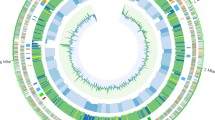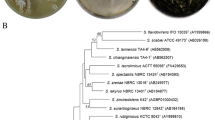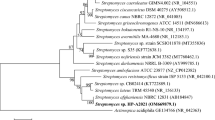Abstract
Streptomyces sp. RS2 was isolated from an unidentified sponge collected around Randayan Island, Indonesia. The genome of Streptomyces sp. RS2 consists of a linear chromosome of 9,391,717 base pairs with 71.9% of G + C content, 8270 protein-coding genes, as well as 18 rRNA and 85 tRNA loci. Twenty-eight putative secondary metabolites biosynthetic gene clusters (BGCs) were identified in the genome sequence. Nine of them have 100% similarity to BGCs for albaflavenone, α-lipomycin, coelibactin, coelichelin, ectoine, geosmin, germicidin, hopene, and lanthionine (SapB). The remaining 19 BGCs have low (< 50%) or moderate (50–80%) similarity to other known secondary metabolite BGCs. Biological activity assays of extracts from 21 different cultures of the RS2 strain showed that SCB ASW was the best medium for the production of antimicrobial and cytotoxic compounds. Streptomyces sp. RS2 has great potential to be a producer of novel secondary metabolites, particularly those with antimicrobial and antitumor activities.


Similar content being viewed by others
Data availability
The complete genome sequence of Streptomyces sp. RS2 has been deposited in the GenBank database under the accession number NZ_JAPCIE000000000.
References
Almeida EL, Carrillo Rincón AF, Jackson SA, Dobson ADW (2019) Comparative genomics of marine sponge-derived Streptomyces spp. isolates SM17 and SM18 with their closest terrestrial relatives provides novel insights into environmental niche adaptations and secondary metabolite biosynthesis potential. Front Microbiol 10:1–22. https://doi.org/10.3389/fmicb.2019.01713
Anteneh YS, Yang Q, Brown MH, Franco CMM (2021) Antimicrobial activities of marine sponge-associated bacteria. Microorganisms 9(1):1–19. https://doi.org/10.3390/microorganisms9010171
Aziz RK, Bartels D, Best A, DeJongh M, Disz T, Edwards RA, Formsma K, Gerdes S, Glass EM, Kubal M, Meyer F, Olsen GJ, Olson R, Osterman AL, Overbeek RA, McNeil LK, Paarmann D, Paczian T, Parrello B, Zagnitko O (2008) The RAST server: rapid annotations using subsystems technology. BMC Genom. 9:1–15. https://doi.org/10.1186/1471-2164-9-75
Becher PG, Verschut V, Bibb MJ, Bush MJ, Molnár BP, Barane E, Al-Bassam MM, Chandra G, Song L, Challis GL, Buttner MJ, Flärdh K (2020) Developmentally regulated volatiles geosmin and 2-methylisoborneol attract a soil arthropod to Streptomyces bacteria promoting spore dispersal. Nat Microbiol 5(6):821–829. https://doi.org/10.1038/s41564-020-0697-x
Blin K, Shaw S, Kloosterman AM, Charlop-Powers Z, Van Wezel GP, Medema MH, Weber T (2021) AntiSMASH 6.0: improving cluster detection and comparison capabilities. Nucleic Acids Res 49(W1):W29–W35. https://doi.org/10.1093/nar/gkab335
Carver T, Thomson N, Bleasby A, Berriman M, Parkhill J (2009) DNAPlotter: Circular and linear interactive genome visualization. Bioinformatics 25(1):119–120. https://doi.org/10.1093/bioinformatics/btn578
Čihák M, Kameník Z, Šmídová K, Bergman N, Benada O, Kofronová O, Petrícková K, Bobek J (2017) Secondary metabolites produced during the germination of Streptomyces coelicolor. Front Microbiol 8:1–13. https://doi.org/10.3389/fmicb.2017.02495
Cock PJA, Antao T, Chang JT, Chapman BA, Cox CJ, Dalke A, Friedberg I, Hamelryck T, Kauff F, Wilczynski B, De Hoon MJL (2009) Biopython: freely available python tools for computational molecular biology and bioinformatics. Bioinformatics 25(11):1422–1423. https://doi.org/10.1093/bioinformatics/btp163
Disz T, Akhter S, Cuevas D, Olson R, Overbeek R, Vonstein V, Stevens R, Edwards RA (2010) Accessing the SEED genome databases via web services API: tools for programmers. BMC Bioinform 11:319
Fotso S, Zabriskie TM, Proteau PJ, Flatt PM, Santosa Sulastri DA, Mahmud T (2009) Limazepines A-F, pyrrolo[1,4]benzodiazepine antibiotics from an Indonesian Micrococcus sp. J Nat Prod 72(4):690–695. https://doi.org/10.1021/np800827w
Galet J, Deveau A, Hôtel L, Frey-Klett P, Leblond P, Aigle B (2015) Pseudomonas fluorescens pirates both ferrioxamine and ferricoelichelin Siderophores from Streptomyces ambofaciens. Appl Environ Microbiol 81(9):3132–3141. https://doi.org/10.1128/AEM.03520-14
Galperin MY, Wolf YI, Makarova KS, Alvarez RV, Landsman D, Koonin EV (2021) COG database update: focus on microbial diversity, model organisms, and widespread pathogens. Nucleic Acids Res 49(D1):D274–D281. https://doi.org/10.1093/nar/gkaa1018
Handayani I, Saad H, Ratnakomala S, Lisdiyanti P, Kusharyoto W, Krause J, Kulik A, Wohlleben W, Aziz S, Gross H, Gavriilidou A, Ziemert N, Mast Y (2021) Mining Indonesian microbial biodiversity for novel natural compounds by a combined genome mining and molecular networking approach. Mar Drugs. https://doi.org/10.3390/md19060316
Hoang NH, Huong NL, Kim B, Sohng JK, Yoon YJ, Park JW (2016) Istamycin aminoglycosides profiling and their characterization in Streptomyces tenjimariensis ATCC 31603 culture using high-performance liquid chromatography with tandem mass spectrometry. J Sep Sci 39(24):4712–4722. https://doi.org/10.1002/jssc.201600925
Indraningrat AAG, Smidt H, Sipkema D (2016) Bioprospecting sponge-associated microbes for antimicrobial compounds. Mar Drugs 14(5):1–66. https://doi.org/10.3390/md14050087
Jia N, Ding MZ, Luo H, Gao F, Yuan YJ (2017) Complete genome sequencing and antibiotics biosynthesis pathways analysis of Streptomyces lydicus 103. Sci Rep 7(February):1–8. https://doi.org/10.1038/srep44786
Kim CK, Riswanto R, Won TH, Kim H, Elya B, Sim CJ, Oh DC, Oh KB, Shin J (2017) Manzamine alkaloids from an Acanthostrongylophora sp. sponge. J Nat Prod 80(5):1575–1583. https://doi.org/10.1021/acs.jnatprod.7b00121
Kodani S, Hudson ME, Durrant MC, Buttner MJ, Nodwell JR, Willey JM (2004) The SapB morphogen is a lantibiotic-like peptide derived from the product of the developmental gene ramS in Streptomyces coelicolor. Proc Natl Acad Sci USA 101(31):11448–11453. https://doi.org/10.1073/pnas.0404220101
Kolmogorov M, Yuan J, Lin Y, Pevzner PA (2019) Assembly of long, error-prone reads using repeat graphs. Nat Biotechnol 37(5):540–546. https://doi.org/10.1038/s41587-019-0072-8
Kunze B, Schabcher K, Zahner H, Zeeck A (1972) Metabolic products of microorganisms. 3 lipomycins. I. Isolation, characterization and first studies of the structure and the mechanism of action. Arch Mikrobiol 86(2):147–174
Li JY, Huang JY, Li M, Zhang H, Xing B, Chen G, Wei D, Gu PY, Hu WX (2012) Anisomycin induces glioma cell death via down-regulation of PP2A catalytic subunit in vitro. Acta Pharmacol Sin 33(7):935–940. https://doi.org/10.1038/aps.2012.46
Liu W, Sun F, Hu Y (2018) Genome mining-mediated discovery of a new avermipeptin analogue in Streptomyces actuosus ATCC.pdf Chem OPEN. Commun 7:558–561
Liu Z, Zhang Y, Sun J, Huang WC, Xue C, Mao X (2020) A novel soluble squalene-hopene cyclase and its application in efficient synthesis of hopene. Front Bioeng Biotechnol 8:1–10. https://doi.org/10.3389/fbioe.2020.00426
Lu C, Shen Y (2007) A novel ansamycin, naphthomycin K from Streptomyces sp. J Antibiot 60(10):649–653. https://doi.org/10.1038/ja.2007.84
Maresca JA, Romberger SP, Bryant DA (2008) Isorenieratene biosynthesis in green sulfur bacteria requires the cooperative actions of two carotenoid cyclases. J Bacteriol 190(19):6384–6391. https://doi.org/10.1128/JB.00758-08
Meyer BN, Ferrigni NA, Putnam JE, Jacobsen LB, Nichols DE, Mclaughlin JL (1982) Brine shrimp: a convenient general bioassay for active plant constituents. J Med Plant Res 45:31–34
Miller-Wideman M, Makkar N, Tran M, Isaac B, Biest N, Stonard R (1992) Herboxidiene, a new herbicidal substance from Streptomyces chromofuscus a7847 taxonomy, fermentation, isolation, physico-chemical and biological properties. J Antibiot 45(6):914–921. https://doi.org/10.7164/antibiotics.45.914
Nofiani R, Weisberg AJ, Tsunoda T, Panjaitan RGP, Brilliantoro R, Chang JH, Philmus B, Mahmud T (2020) Antibacterial potential of secondary metabolites from Indonesian marine bacterial symbionts. Int J Microbiol. https://doi.org/10.1155/2020/8898631
Oh DC, Poulsen M, Currie CR, Clardy J (2011) Sceliphrolactam, a polyene macrocyclic lactam from a wasp-associated Streptomyces sp. Org Lett 13(4):752–755. https://doi.org/10.1021/ol102991d
Overbeek R, Olson R, Pusch GD, Olsen GJ, Davis JJ, Disz T, Edwards RA, Gerdes S, Parrello B, Shukla M, Vonstein V, Wattam AR, Xia F, Stevens R (2014) The SEED and the rapid annotation of microbial genomes using subsystems technology (RAST). Nucleic Acids Res 42(D1):206–214. https://doi.org/10.1093/nar/gkt1226
Pajor M, Sogin J, Worobo RW, Szweda P (2020) Draft genome sequence of antimicrobial producing Paenibacillus alvei strain MP1 reveals putative novel antimicrobials. BMC Res Notes 13(1):4–9. https://doi.org/10.1186/s13104-020-05124-z
Prabhu J, Schauwecker F, Grammel N, Keller U, Bernhard M (2004) Functional expression of the ectoine hydroxylase gene (thpD) from Streptomyces chrysomallus in Halomonas elongata. Appl Environ Microbiol 70(5):3130–3132. https://doi.org/10.1128/AEM.70.5.3130-3132.2004
Pramanik S, Chakraborty S, Sivan M, Patro BS, Chatterjee S, Goswami D (2019) Cell permeable imidazole-desferrioxamine conjugates: synthesis and in vitro evaluation. Bioconj Chem 30(3):841–852. https://doi.org/10.1021/acs.bioconjchem.8b00924
Schwibbert K, Marin-Sanguino A, Bagyan I, Heidrich G, Lentzen G, Seitz H, Rampp M, Schuster SC, Klenk HP, Pfeiffer F, Oesterhelt D, Kunte HJ (2011) A blueprint of ectoine metabolism from the genome of the industrial producer Halomonas elongata DSM 2581 T. Environ Microbiol 13(8):1973–1994. https://doi.org/10.1111/j.1462-2920.2010.02336.x
Seemann T (2014) Prokka: rapid prokaryotic genome annotation. Bioinformatics 30(14):2068–2069. https://doi.org/10.1093/bioinformatics/btu153
Tanamatayarat P (2016) Antityrosinase, antioxidative activities, and brine shrimp lethality of ethanolic extracts from Protium serratum (Wall. ex Colebr.) Engl. Asian Pac J Trop Biomed 6(12):1050–1055. https://doi.org/10.1016/j.apjtb.2016.10.001
Tangerina MMP, Furtado LC, Leite VMB, Bauermeister A, Velasco-Alzate K, Jimenez PC, Garrido LM, Padilla G, Lopes NP, Costa-Lotufo LV, Pena Ferreira MJ (2021) Metabolomic study of marine Streptomyces sp.: secondary metabolites and the production of potential anticancer compounds. PLoS One 15(12):1–19. https://doi.org/10.1371/journal.pone.0244385
Tatusova T, Dicuccio M, Badretdin A, Chetvernin V, Nawrocki EP, Zaslavsky L, Lomsadze A, Pruitt KD, Borodovsky M, Ostell J (2016) NCBI prokaryotic genome annotation pipeline. Nucleic Acids Res 44(14):6614–6624. https://doi.org/10.1093/nar/gkw569
Thirumurugan D, Cholarajan A, Raja SSS, Vijaykumar R (2018) Secondary metabolites. In: Vijayakumar R, Raja S (eds) 5th edn. https://www.intechopen.com/books/advanced-biometric-technologies/liveness-detection-in-biometrics
Valderrama K, Pradel E, Firsov AM, Drobecq H, Roy le HB, Villemagne B, Antonenko YN, Hartkoorn RC (2019) Pyrrolomycins are potent natural protonophores Antimicrob Agents Chemother 63(10):e01450–19. https://doi.org/10.1128/AAC.01450-19
Vertesy L, Ehlers E, Kogler H, Kurz M, Meiwes J, Seibert G, Vogel M, Hammann P (2000) Friulimicins: novel lipopeptide antibiotics with peptidoglycan synthesis inhibiting activity from Actinoplanes friuliensis sp. nov. II. Isolation and structural characterization. J Antibiot 53(8):816–827. https://doi.org/10.7164/antibiotics.53.816
Wang L, Shao Z (2021) Complete genome sequence of a denitrifying bacterium Halomonas sp. SS10-MC5 isolated from hydrothermal vent of Indian Ocean. Mar Genom 58(January):100849. https://doi.org/10.1016/j.margen.2021.100849
Waters AL, Peraud O, Kasanah N, Sims JW, Kothalawala N, Anderson MA, Abbas SH, Rao KV, Jupally VR, Kelly M, Dass A, Hill RT, Hamann MT (2014) An analysis of the sponge Acanthostrongylophora igens’ microbiome yields an actinomycete that produces the natural product manzamine A. Front Mar Sci. https://doi.org/10.3389/fmars.2014.00054
Wick RR, Schultz MB, Zobel J, Holt KE (2015) Bandage: interactive visualization of de novo genome assemblies. Bioinformatics 31(20):3350–3352. https://doi.org/10.1093/bioinformatics/btv383
Wick RR, Judd LM, Gorrie CL, Holt KE (2017) Unicycler: resolving bacterial genome assemblies from short and long sequencing reads. PLoS Comput Biol 13(6):1–22. https://doi.org/10.1371/journal.pcbi.1005595
Yuzawa S, Eng CH, Katz L, Keasling JD (2014) Enzyme analysis of the polyketide synthase leads to the discovery of a novel analog of the antibiotic α-lipomycin. J Antibiot 67(2):199–201. https://doi.org/10.1038/ja.2013.110
Zhao B, Moody SC, Hider RC, Lei L, Kelly SL, Waterman MR, Lamb DC (2012) Structural analysis of cytochrome P450 105N1 involved in the biosynthesis of the zincophore, coelibactin. Int J Mol Sci 13(7):8500–8513. https://doi.org/10.3390/ijms13078500
Zheng D, Ding N, Jiang Y, Zhang J, Ma J, Chen X, Liu J, Han L, Huang X (2016) Albaflavenoid, a new tricyclic sesquiterpenoid from Streptomyces violascens. J Antibiot 69(10):773–775. https://doi.org/10.1038/ja.2016.12
Funding
This research was funded by the Directorate of Research, Technology and Community Service; Directorate General of Higher Education, Research and Technology; Ministry of Education, Culture, Research and Technology with a research scheme: National Competitive Basic Research (Penelitian Dasar Kompetitif Nasional) with contract number 147/E5/PG/2022, date 10 Mei 2022. Work at Oregon State University was funded by the OSU College of Pharmacy Faculty Development Funds to TM. We thank the Department of Botany and Plant Pathology for supporting the computing infrastructure.
Author information
Authors and Affiliations
Contributions
RN was involved in research design, processing, interpretation of the experimental data, and writing the manuscript. TM contributed to research design and revising the manuscript. AW was involved in sequencing, assembly and revising the manuscript. JC contributed to revising the manuscript. Ri, Ru, AS, PA were involved in cultivation, extraction and bioassays. SA contributed to annotation of the genome. All authors read and approved the final manuscript.
Corresponding author
Ethics declarations
Conflict of interest
The authors declare that there are no conflicts of interest.
Additional information
Communicated by Yusuf Akhter.
Publisher's Note
Springer Nature remains neutral with regard to jurisdictional claims in published maps and institutional affiliations.
Rights and permissions
Springer Nature or its licensor (e.g. a society or other partner) holds exclusive rights to this article under a publishing agreement with the author(s) or other rightsholder(s); author self-archiving of the accepted manuscript version of this article is solely governed by the terms of such publishing agreement and applicable law.
About this article
Cite this article
Nofiani, R., Rudiyansyah, Ardiningsih, P. et al. Genome features and secondary metabolite potential of the marine symbiont Streptomyces sp. RS2. Arch Microbiol 205, 244 (2023). https://doi.org/10.1007/s00203-023-03556-2
Received:
Revised:
Accepted:
Published:
DOI: https://doi.org/10.1007/s00203-023-03556-2




